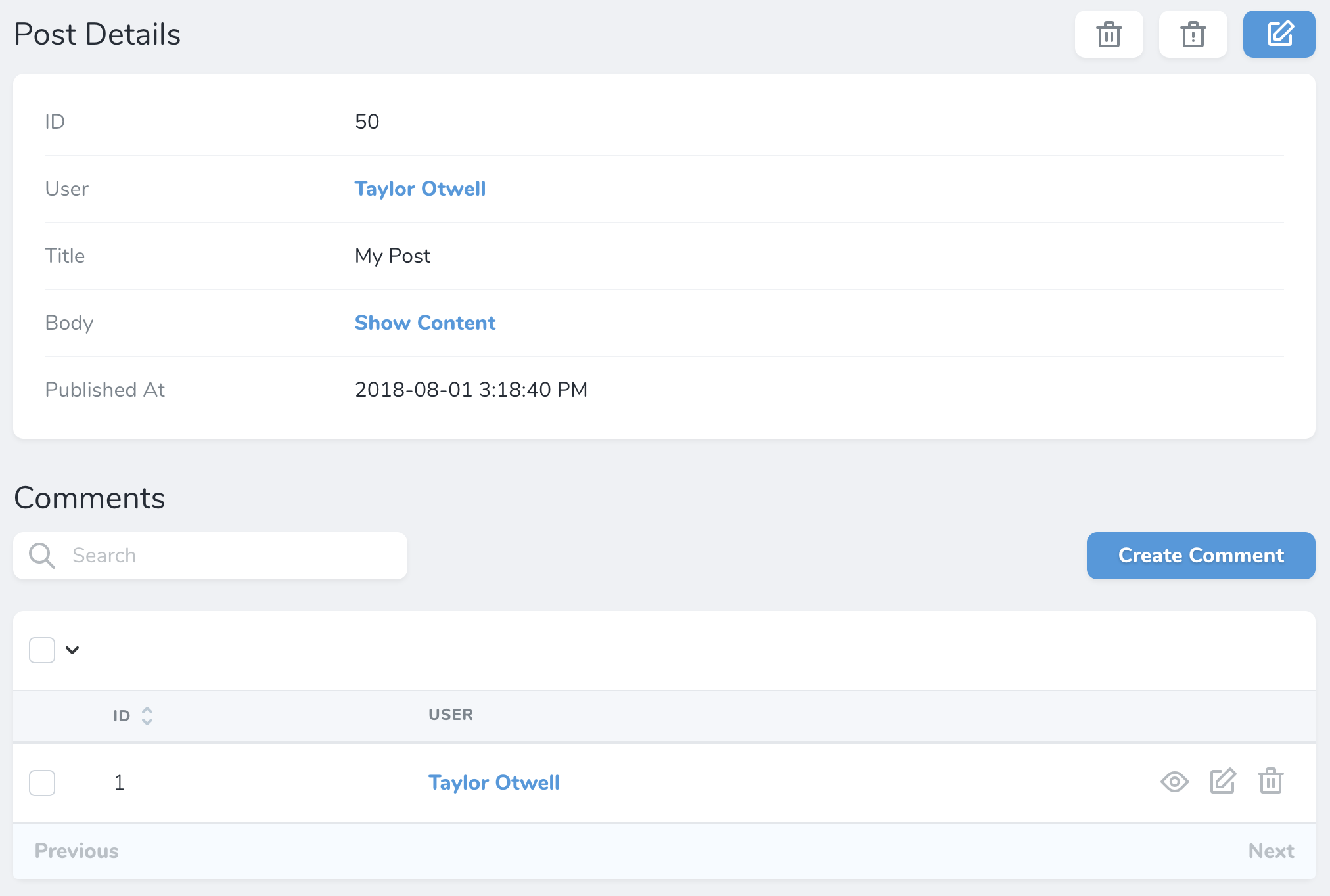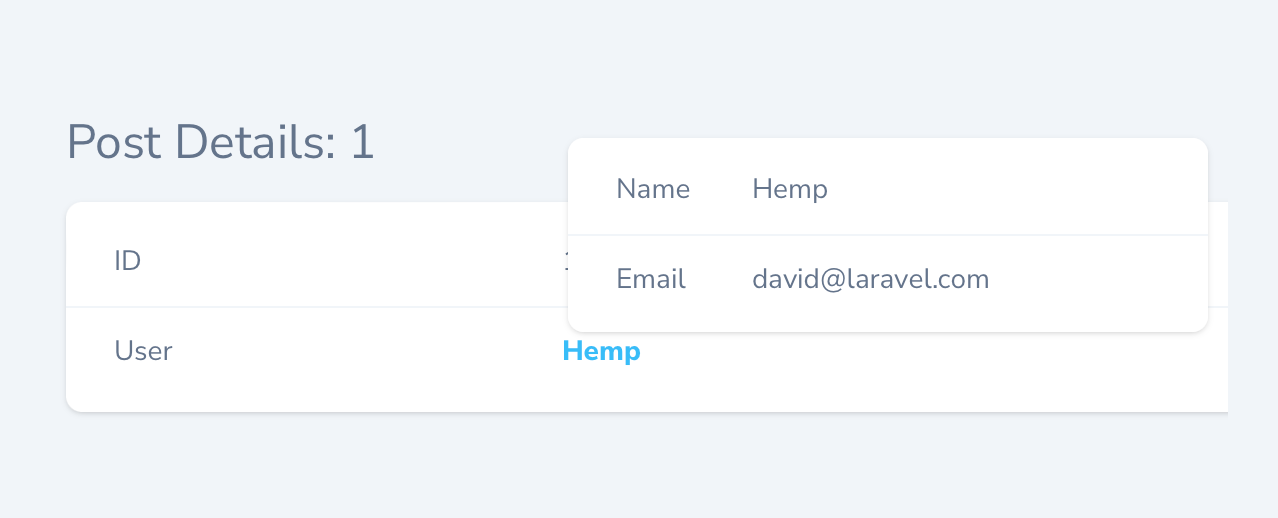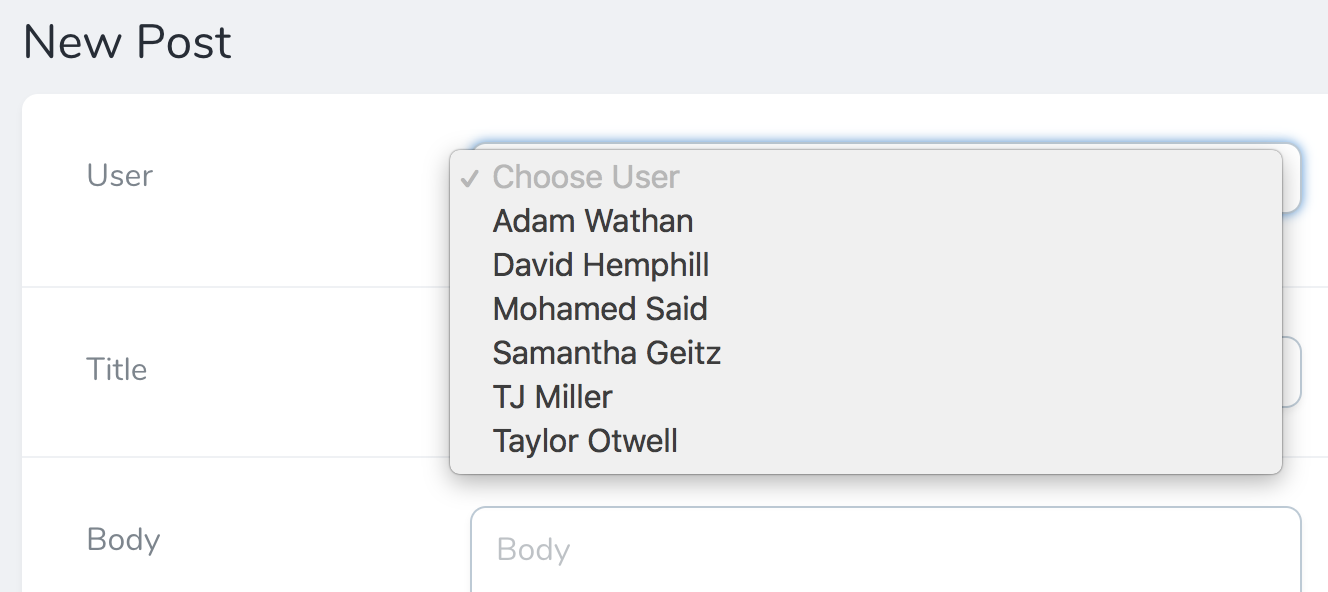
HasOne
TheHasOne field corresponds to a hasOne Eloquent relationship. For example, let’s assume a User model hasOne Address model. We may add the relationship to our User Nova resource like so:
make method:
HasOneOfMany
TheHasOne relationship field can be transformed into an “has one of many” Eloquent relationship using the ofMany method. For example, let’s assume a User model hasMany Post models. We may add the “has one of many” relationship to our User Nova resource like so:
HasMany
TheHasMany field corresponds to a hasMany Eloquent relationship. For example, let’s assume a User model hasMany Post models. We may add the relationship to our User Nova resource like so:
When defining
HasMany relationships, make sure to use the plural form of the relationship so Nova can infer the correct singular resource name:HasOneThrough
TheHasOneThrough field corresponds to a hasOneThrough Eloquent relationship. For example, let’s assume a Mechanic model has one Car, and each Car may have one Owner. While the Mechanic and the Owner have no direct connection, the Mechanic can access the Owner through the Car itself. You can display this relationship by adding it to your Nova resource:
HasManyThrough
TheHasManyThrough field corresponds to a hasManyThrough Eloquent relationship. For example, a Country model might have many Post models through an intermediate User model. In this example, you could easily gather all blog posts for a given country. To display this relationship within Nova, you may add it to your Nova resource:
BelongsTo
TheBelongsTo field corresponds to a belongsTo Eloquent relationship. For example, let’s assume a Post model belongsTo a User model. We may add the relationship to our Post Nova resource like so:
You may customize the resource class used by the relation field by providing the second and third arguments of the
make method, which define the name of the relationship and the underlying Nova resource class:Peeking at BelongsTo Relationships
When hovering over aBelongsTo link when viewing the index or detail views, Nova will show a small card allowing you to “take a peek” at the linked relation:

Preventing Peeking at BelongsTo Relationships
Relationship peeking is enabled by default; however, you can prevent the user from peeking at the relation using the noPeeking helper on your BelongsTo field:
peekable method to determine whether the user should be allowed to peek at the relation:
Nullable Relationships
If you would like yourBelongsTo relationship to be nullable, you may simply chain the nullable method onto the field’s definition:
Title Attributes
When aBelongsTo field is shown on a resource creation / update page, a drop-down selection menu or search menu will display the “title” of the resource. For example, a User resource may use the name attribute as its title. Then, when the resource is shown in a BelongsTo selection menu, that attribute will be displayed:

title property or title method on the resource class:
Disable Ordering by Title
By default, associatable resources will be sorted by their title when listed in a select dropdown. Using thedontReorderAssociatables method, you can disable this behavior so that the resources as sorted based on the ordering specified by the relatable query:
Filter Trashed Items
By default, theBelongsTo field will allow users to select soft-deleted models; however, this can be disabled using the withoutTrashed method:
BelongsToMany
TheBelongsToMany field corresponds to a belongsToMany Eloquent relationship. For example, let’s assume a User model belongsToMany Role models:
app/Models/User.php
User Nova resource like so:
app/Nova/User.php
make method:
Pivot Fields
If yourbelongsToMany relationship interacts with additional “pivot” fields that are stored on the intermediate table of the many-to-many relationship, you may also attach those to your BelongsToMany Nova relationship. Once these fields are attached to the relationship field, and the relationship has been defined on both of the related models / resources, they will be displayed on the related resource index.
For example, let’s assume our User model belongsToMany Role models. On our role_user intermediate table, let’s imagine we have a notes field that contains some simple text notes about the relationship. We can attach this pivot field to the BelongsToMany field using the fields method:
app/Nova/User.php
BelongsToMany field on the User resource, we would define its inverse on the Role resource:
app/Nova/Role.php
Don’t forget to define the pivot fields inside your Model’s relationship definition using the
withPivot method:
https://laravel.com/docs/eloquent-relationships#retrieving-intermediate-table-columnsfields method:
RoleUserFields class would be a simple, invokable class that returns the array of pivot fields:
Pivot Computed Fields
Laravel Nova also allows you to define computed fields within the field list of abelongsToMany relationship field:
Pivot Actions
Typically, Nova actions operate on a resource. However, you may also attach actions tobelongsToMany fields so that they can operate on pivot / intermediate table records. To accomplish this, you may chain the actions method onto your field’s definition:
To learn more about Nova actions, check out the complete action documentation.
Title Attributes
When aBelongsToMany field is shown on a resource creation / update page, a drop-down selection menu or search menu will display the “title” of the resource. For example, a Role resource may use the name attribute as its title. Then, when the resource is shown in a BelongsToMany selection menu, that attribute will be displayed:

title property or title method on the resource class:
Disabling Ordering by Title
By default, associatable resources will be sorted by their title when listed in a select dropdown. Using thedontReorderAttachables method, you can disable this behavior so that the resources as sorted based on the ordering specified by the relatable query:
Allowing Duplicate Relations
By default, Laravel Nova ensures that “belongs to many” relationships are unique. However, if necessary, you may instruct Nova to allow duplicate relationship entries. To get started, you should ensure that your pivot record’sid column is available by using the withPivot method when defining the relationship on your Eloquent model. In this example, let’s imagine that a User may purchase a Book one or more times:
app/Models/User.php
allowDuplicateRelations method:
MorphOne
TheMorphOne field corresponds to a morphOne Eloquent relationship. For example, let’s assume a Post has a one-to-one polymorphic relationship with the Image model. We may add the relationship to our Post Nova resource like so:
MorphOneOfMany
TheMorphOne relationship field can be transformed into a “morph one of many” Eloquent relationship using the ofMany method. For example, let’s assume a Post has a one-to-many polymorphic relationship with the Comment model. We may add the relationship to our Post Nova resource like so:
MorphMany
TheMorphMany field corresponds to a morphMany Eloquent relationship. For example, let’s assume a Post has a one-to-many polymorphic relationship with the Comment model. We may add the relationship to our Post Nova resource like so:
MorphTo
TheMorphTo field corresponds to a morphTo Eloquent relationship. For example, let’s assume a Comment model has a polymorphic relationship with both the Post and Video models. We may add the relationship to our Comment Nova resource like so:
types method is used to instruct the MorphTo field what types of resources it may be associated with. Nova will use this information to populate the MorphTo field’s type selection menu on the creation and update pages:

When a
MorphTo field is shown on a resource creation / update page, the title attributes of the available resources will automatically be displayed.Nullable MorphTo Relationships
If you would like your MorphTo relationship to be nullable, chain the nullable method onto the field’s definition:
Peeking at MorphTo Relationships
When hovering over a MorphTo link when viewing the index or detail views, Nova will show a small card allowing you to “take a peek” at the linked relation:

Preventing Peeking at MorphTo Relationships
Relationship peeking is enabled by default; however, you can prevent the user from peeking at the relation using the noPeeking helper on your MorphTo field:
peekable method to determine whether the user should be allowed to peek at the relation:
Setting Default Values on MorphTo Relationships
When setting the default value for a MorphTo field, in addition to setting the field’s initial value using the default method, you also need to specify the class name of the resource to be used. You may accomplish this via the defaultResource method:
MorphToMany
TheMorphToMany field corresponds to a morphToMany Eloquent relationship. For example, let’s assume a Post has a many-to-many polymorphic relationship with the Tag model. We may add the relationship to our Post Nova resource like so:
Pivot Fields
If yourmorphToMany relationship interacts with additional “pivot” fields that are stored on the intermediate table of the many-to-many relationship, you may also attach those to your MorphToMany Nova relationship. Once these fields are attached to the relationship field, they will be displayed on the related resource index.
For example, on our taggables intermediate table, let’s imagine we have a notes field that contains some simple text notes about the relationship. We can attach this pivot field to the MorphToMany field using the fields method:
app/Nova/Post.php
MorphToMany field on the Post resource, we would define it’s inverse on the Tag resource:
app/Nova/Tag.php
Don’t forget to define the pivot fields inside your Model’s relationship definition using the
withPivot method:
https://laravel.com/docs/eloquent-relationships#retrieving-intermediate-table-columnsfields method:
TaggableFields class would be a simple, invokable class that returns the array of pivot fields:
app/Nova/TaggableFields.php
Title Attributes
When aMorphToMany field is shown on a resource creation / update page, a drop-down selection menu or search menu will display the “title” of the resource. For example, a Tag resource may use the name attribute as its title. Then, when the resource is shown in a MorphToMany selection menu, that attribute will be displayed:

title property or title method on the resource class:
Collapsable Relations
By default, theBelongsToMany, HasMany, and MorphToMany relationship fields are shown on the resource detail page. However, this can quickly become cumbersome if a resource has many performance-intensive relationships which cause the page to be slow.
For this reason, Nova allows you to mark as relationship as collapsable. When a relationship is collapsable, users may collapse some of the relations for a given resource and Nova will remember their preferences on subsequent page loads. Collapsed relationships are not retrieved from the database until the relationship is expanded in Nova’s user interface:
collapsedByDefault method:
Searchable Relations
By default, when theBelongsTo, MorphTo, BelongsToMany and MorphToMany relationship fields are shown on a resource creation / update page, a simple drop-down selection menu will be displayed. However, this can quickly become cumbersome if a resource model has many records. For example, imagine a drop-down selection menu populated with over 10,000 users!
Instead of displaying a drop-down selection menu, you may mark your relationships as searchable. When a relationship is marked as searchable, a beautiful search input control will be displayed instead:

searchable, chain the searchable method onto the field’s definition. If you would like to conditionally determine if a field should be searchable, you may pass a closure to the searchable method:
withSubtitles method when defining the field:
Relatable Query Filtering
If you would like to customize the relatable query, you may do so by invoking therelatableQueryUsing method:
relatableQueryUsing method may also prove useful when you need to adjust the query based on the value of another field:
Limiting Relation Results
You can limit the number of results that are returned when searching the field by defining arelatableSearchResults property on the class of the resource that you are searching for:
app/Nova/~Resource.php
Creating Inline Relations
For convenience, WhenBelongsTo or MorphTo relationship fields are shown on a resource create or update page, you may create the related resource inline via a modal window without leaving the creation / update page:

showCreateRelationButton method when defining the relationship field:
showCreateRelationButton method to conditionally determine if inline resource creation should be enabled:
showCreateRelationButton when defining a BelongsToMany or MorphToMany relationship:
hideCreateRelationButton method when defining the relationship field:
Inline Creation Modal Size
You may adjust the size of the modal using themodalSize method:
Inline relation creation only supports creating relations one level deep. This means you cannot trigger an additional inline creation modal inside an existing inline creation modal. Instead, you must select a resource that already exists.